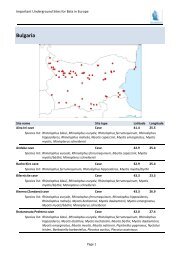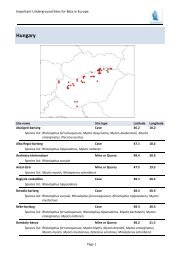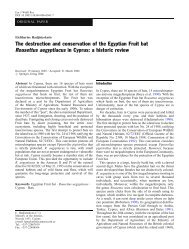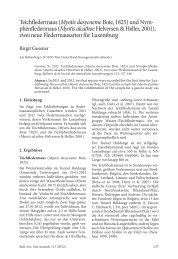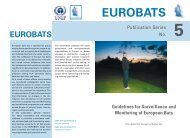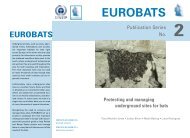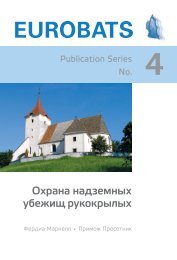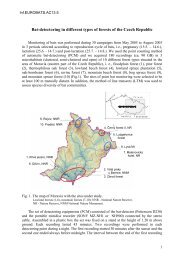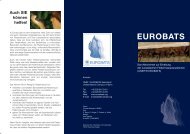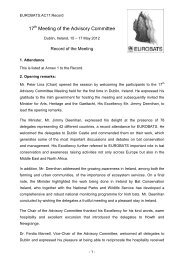1991 - 2006. EUROBATS celebrates its 15th anniversary
1991 - 2006. EUROBATS celebrates its 15th anniversary
1991 - 2006. EUROBATS celebrates its 15th anniversary
You also want an ePaper? Increase the reach of your titles
YUMPU automatically turns print PDFs into web optimized ePapers that Google loves.
Recent conservation activities<br />
In recent years, the research and conser-<br />
vation activities, described in the natio-<br />
nal implementation reports, included: a)<br />
monitoring programme of cave-dwelling<br />
species, b) roosts protection (fencing, vegetation<br />
clearance, prevention of stone falling),<br />
c) comparison of the stress periods in<br />
Portugal and Germany and study of several<br />
ecological aspects of Myotis myotis, d) study<br />
of the diet of Myotis myotis, e) development<br />
of bat-boxes for Mediterranean areas,<br />
f) study of the habitat use by Tadarida teniotis,<br />
g) study of the impact of parasitism on<br />
reproduction in bats, h) evaluation of the situation<br />
of bat species in the archipelagos of<br />
Madeira and Azores, i) confirmation of the<br />
presence of P. pipistrellus and P. pygmaeus,<br />
j) creation of an Interpretation Centre in a<br />
Natural Park (with an observatory where visitors<br />
can observe the bats inside the cave<br />
using infrared cameras), k) study of ecological<br />
aspects of Barbastella barbastellus,<br />
and l) construction of artificial roosts (200<br />
bat-boxes, two underground galleries and<br />
one building).<br />
The role of <strong>EUROBATS</strong><br />
Portugal signed <strong>EUROBATS</strong> in June 1993<br />
and confirmed the ratification instrument<br />
in January 1996.<br />
The accession to this Agreement highlighted<br />
the importance of bats in the country<br />
and created a link to the activities carried<br />
out by Instituto da Conservação da<br />
Natureza.<br />
The implementation of the <strong>EUROBATS</strong><br />
resolutions and the application of the prepared<br />
guidelines, has been taken into consideration<br />
for the following activities:<br />
<strong>1991</strong>-2006 • <strong>EUROBATS</strong> <strong>celebrates</strong> <strong>its</strong> 15 th <strong>anniversary</strong><br />
• The monitoring programme for cavedwelling<br />
species using the methodologies<br />
described in Resolution 2.1;<br />
• A list of the important underground<br />
roosts was prepared according to Resolution<br />
2.4;<br />
• A study of the migratory patterns of<br />
some cave-dwelling species (Miniopterus<br />
schreibersii, Myotis myotis and Myotis<br />
blythii) has been conducted in a few<br />
roosts, as recommended in Resolution<br />
2. ;<br />
• The list of activities has been selected<br />
in agreement with the conservation and<br />
management plan approved by EURO-<br />
BATS (Resolutions 2.8, 3.3 and 4.9);<br />
• Underground roosts have been protected<br />
accordingly to Resolution 4.3;<br />
• Perm<strong>its</strong> regarding the capture and study<br />
of captured wild bats have been prepared,<br />
taking into consideration the guidelines<br />
described in Resolution 4.6;<br />
• Analysis of impact assessment studies<br />
for wind parks in areas of particular value<br />
to bat populations have taken into<br />
account Resolution 4.7.<br />
In addition, implementation reports have<br />
also been prepared following the approved<br />
format (Resolutions 2.7 and 3.3). Nevertheless,<br />
there are still two resolutions that have<br />
not been implemented yet: Resolution 3.7<br />
on the Amendment of the Agreement and<br />
Resolution 4.4 on Bat Conservation and Sustainable<br />
Forest Management.<br />
77



